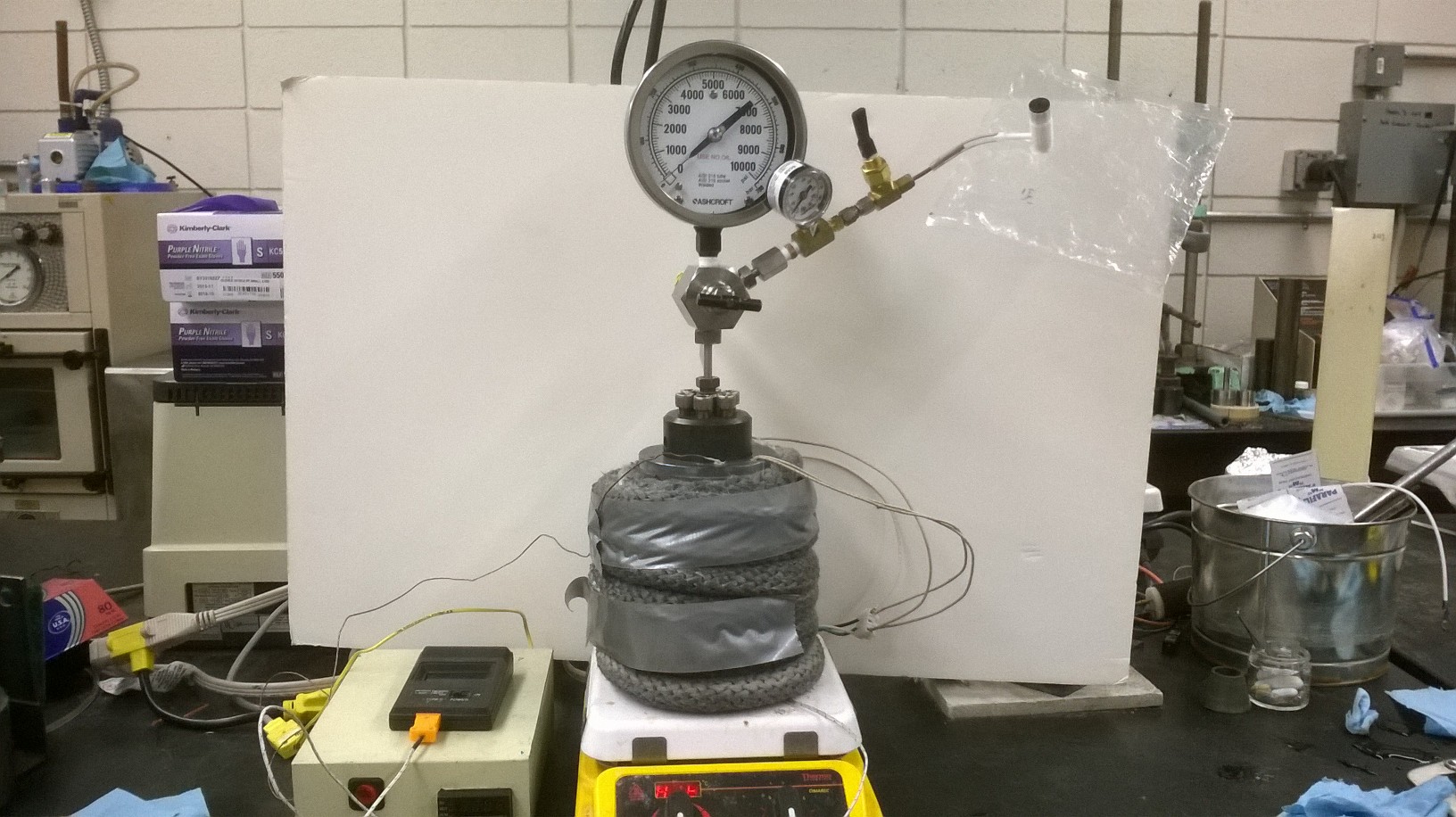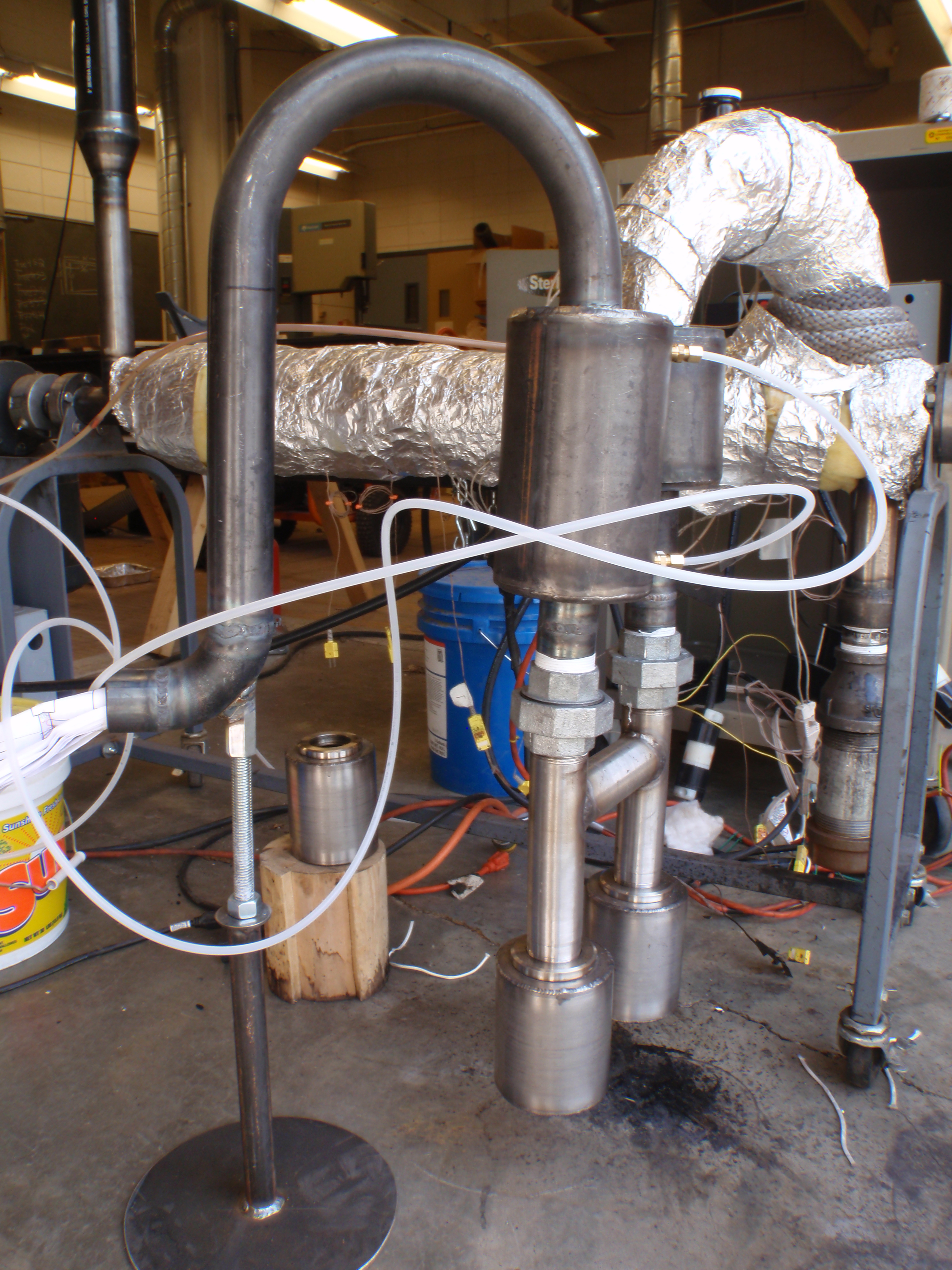Biomass Treatment
The algal biomass and the residual bacterial biomass (RBB) from the PHA reactor can be treated by either hydrothermal liquefaction (HTL) or pyrolysis.
Hydrothermal Liquefaction
 HTL of whole algae is an attractive process since wet slurries are readily accommodated. Thus, minimal dewatering (an energy intensive step) is minimized. The slurry is hydrothermally treated in subcritical water, typically at pressures between 13.8 to 20.7 MPa and temperatures ranging from 300 to 350°C.1 Primary products are bio-oil and an aqueous phase. The aqueous phase contains sugars2 and protein derived N-containing compounds3 that can be recycled to the fermenter to augment PHA production. Small amounts of gases and solids are also formed. The solids are high in phosphorus content and can be recycled back to the algae ponds.
HTL of whole algae is an attractive process since wet slurries are readily accommodated. Thus, minimal dewatering (an energy intensive step) is minimized. The slurry is hydrothermally treated in subcritical water, typically at pressures between 13.8 to 20.7 MPa and temperatures ranging from 300 to 350°C.1 Primary products are bio-oil and an aqueous phase. The aqueous phase contains sugars2 and protein derived N-containing compounds3 that can be recycled to the fermenter to augment PHA production. Small amounts of gases and solids are also formed. The solids are high in phosphorus content and can be recycled back to the algae ponds.
HTL of the RBB from the PHA reactor has the potential to generate value-added bioproducts from materials that would otherwise be discarded as waste.4 The RBB is protein- (i.e., nitrogen) and carbohydrate-rich material comprised of lysed bacterial cells. Freeze-dried biomass containing PHBV stored in the bacterial cells is first batch extracted with acetone to remove lipids, and then Soxhlet extracted with CHCl3 to recover the PHBV. Then, direct HTL is performed to hydrolyze the proteins, nucleic acids, carbohydrates, and lipids at temperatures from 150 to 250°C. This converts the biomass into useful products, such as water-soluble products and organic oils (bio-oils). The water-soluble portion can be recycled to the fermenter as carbon and nitrogen sources to biosynthesize additional PHA.
Pyrolysis
 Pyrolysis is the heating of an organic material, such as biomass (wood, food wastes, bacterial residuals, etc), in the absence of oxygen.5,6 Without oxygen, combustion does not occur. Rather, the chemical compounds (i.e., cellulose, hemicellulose and lignin) that comprise the material thermally decompose into combustible gases and charcoal. Most of these combustible gases can be condensed into combustible liquid, called pyrolysis oil (bio-oil), though there are gases released in the process (CO2, CO, H2, light hydrocarbons). The pyrolysis of biomass produces three products: bio-oil (liquid), bio-char (solid) and syngas (gas). The proportion of these products depends on several factors that include the feedstock composition and process parameters, which is the subject of continuing research. The primary compounds in the bio-oil are hydrocarbons, such as mono-aromatic hydrocarbons and phenolic compounds, which include toluene and phenolic compounds; aliphatic ketone, including pentanone and cyclopentanedione; nitrogen and oxygen containing aromatic compounds, such as pyrrole, indole, and pyridinyl products; aliphatic compounds and amines; and carboxylic acids. Since the biochar contains considerable amounts of inorganic nitrogen, it is suitable for fertilizer. Nitrogen-rich pyrolysis oil can be recycled back to the PHA reactor or fermenter to augment production.
Pyrolysis is the heating of an organic material, such as biomass (wood, food wastes, bacterial residuals, etc), in the absence of oxygen.5,6 Without oxygen, combustion does not occur. Rather, the chemical compounds (i.e., cellulose, hemicellulose and lignin) that comprise the material thermally decompose into combustible gases and charcoal. Most of these combustible gases can be condensed into combustible liquid, called pyrolysis oil (bio-oil), though there are gases released in the process (CO2, CO, H2, light hydrocarbons). The pyrolysis of biomass produces three products: bio-oil (liquid), bio-char (solid) and syngas (gas). The proportion of these products depends on several factors that include the feedstock composition and process parameters, which is the subject of continuing research. The primary compounds in the bio-oil are hydrocarbons, such as mono-aromatic hydrocarbons and phenolic compounds, which include toluene and phenolic compounds; aliphatic ketone, including pentanone and cyclopentanedione; nitrogen and oxygen containing aromatic compounds, such as pyrrole, indole, and pyridinyl products; aliphatic compounds and amines; and carboxylic acids. Since the biochar contains considerable amounts of inorganic nitrogen, it is suitable for fertilizer. Nitrogen-rich pyrolysis oil can be recycled back to the PHA reactor or fermenter to augment production.
1 Jones, S.B., et al. (2014). Process design and economics for the conversion of algal biomass to hydrocarbons: whole algae hydrothermal liquefaction and upgrading.
PNNL-23227, Pacific Northwest National Laboratory, Richland, Washington, USA.
2 Chakraborty, M. et al. (2013). An α-glucan isolated as a co-product of biofuel by hydrothermal liquefaction of Chlorella sorokiniana biomass,
Algal Research 2, 230-236.
3 Liang, S., Wei, L., Passero, M., Feris, K., McDonald, A.G., (2015) Hydrothermal treatment of algae, in preparation.
4 Wei, L, Liang, S., Coats, E.R., and McDonald, A.G. (2015). Hydrothermal treatment of residual bacteria biomass waste derived from polyhydroxyalkanoate production process,
Bioresource Technology, in review.
5 Liang, S., Han, Y., Wei, L., McDonald, A.G., (2015). Production and characterization of bio-oil and bio-char from pyrolysis of potato peel wastes.
Biomass Conversion and Biorefinery 5(3), 237-246.
6 Wei, L., Guho, N.M., Coats, E.R., and McDonald, A.G. (2014). Characterization of poly(3-hydroxybutyrate-co−3-hydroxyvalerate) biosynthesized by mixed microbial consortia fed fermented dairy manure,
J Appl Polym Sci. 131(11).

